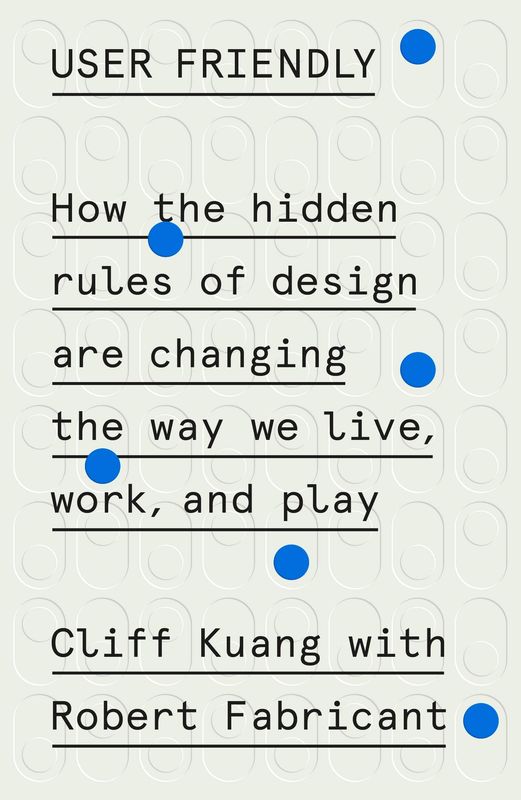User Friendly Book Summary
In 'User Friendly', authors Cliff Kuang and Robert Fabricant delve into the evolution of design and its profound impact on our daily lives. They explore how user experience shapes technology and our interactions with it, revealing the hidden forces at play in the digital world. From the origins of design thinking to the future of interaction, the book challenges conventional notions of usability. Readers will discover how empathy and human-centered design can transform products into experiences. This thought-provoking exploration not only invites curiosity but also encourages a reevaluation of our relationship with technology.
By Cliff Kuang, Robert Fabricant
Published: 2019
"Design is not just what it looks like; it’s how it works. The true essence of user-friendly design is the seamless interplay between functionality and experience."
Book Review of User Friendly
In User Friendly, Cliff Kuang and Robert Fabricant reveal the untold story of a paradigm that quietly rules our modern lives: the assumption that machines should anticipate what we need. Spanning over a century of sweeping changes, from women’s rights to the Great Depression to World War II to the rise of the digital era, this book unpacks the ways in which the world has been—and continues to be—remade according to the principles of the once-obscure discipline of user-experience design. In this essential text, Kuang and Fabricant map the hidden rules of the designed world and shed light on how those rules have caused our world to change—an underappreciated but essential history that’s pieced together for the first time. Combining the expertise and insight of a leading journalist and a pioneering designer, User Friendly provides a definitive, thoughtful, and practical perspective on a topic that has rapidly gone from arcane to urgent to inescapable. In User Friendly, Kuang and Fabricant tell the whole story for the first time—and you’ll never interact with technology the same way again.
Book Overview of User Friendly
About the Book Authors
Cliff Kuang
Cliff Kuang is an acclaimed author and design journalist known for his insightful analysis of technology and its impact on society. He has contributed to notable publications such as Wired and Fast Company, where he explores the intersections of design, technology, and culture. Kuang's recent book, "User-Friendly: How the Hidden Rules of Design Are Changing the Way We Live, Work, and Play," delves into the principles of user experience and how design shapes our daily interactions. His writing is characterized by a blend of clarity and depth, making complex topics accessible to a broad audience.
Robert Fabricant
Robert Fabricant is an acclaimed author known for his thought-provoking novels and engaging storytelling. He has written several notable works, including 'The Guardian of the Abyss' and 'Echoes of Silence,' which explore themes of identity, morality, and the impact of technology on society. Fabricant's writing style blends lyrical prose with sharp dialogue, creating immersive narratives that resonate with readers. In addition to his fiction work, he frequently contributes to literary journals and speaks at writing workshops, inspiring the next generation of writers.
Book Details
Key information about the book.
- Authors
- Cliff Kuang, Robert Fabricant
- Published
- November 2019
- Publisher
- MCD
- ISBN
- 0374279756
- Language
- English
- Pages
- 416
- Genres
- Design ThinkingDesign
Purchase Options
Support local bookstores: BookShop gives a portion of each sale to independent bookshops!
Similar books you might like →
Technopoly Book Summary
In 'Technopoly,' Neil Postman explores the complex relationship between technology and culture, arguing that society's obsession with technology can lead to a dangerous loss of critical thought and human values. He illustrates how technological advancements can dominate cultural discourse, making other perspectives obsolete. Postman warns that as we become increasingly reliant on technology, we risk losing essential skills like reasoning and communication. With a keen eye for the implications of technological dominance, he urges readers to reflect on the values that should guide technological progress. This provocative examination challenges us to consider whether we are the masters of our creations or merely servants to them.
The Designer's Dictionary of Type Book Summary
Delve into the fascinating world of typography with 'The Designer's Dictionary of Type' by Sean Adams. This comprehensive guide unravels the intricacies of typefaces, revealing their unique personalities and historical contexts. Each entry offers insights that inspire creativity and enhance design skills, making it an essential reference for both novice and seasoned designers. With stunning visual examples, the book encourages a deeper appreciation for the art and science of type. Discover how the right type can transform your work and captivate your audience!
Any Human Heart Book Summary
'Any Human Heart' by William Boyd follows the life of Logan Mountstuart, a man whose experiences span the 20th century, reflecting both the personal and historical upheavals of the time. Through a series of journal entries, we witness his romantic entanglements, artistic pursuits, and the complexities of human relationships. Logan's journey reveals how love, loss, and desire intertwine in the tapestry of life, making one ponder the true essence of humanity. With wit and introspection, Boyd invites readers to explore the fragility of existence and the indelible marks left by every encounter. Will you uncover the secrets hidden within Logan's heart?
Moonwalking with Einstein Book Summary
In 'Moonwalking with Einstein', Joshua Foer takes readers on a mesmerizing journey through the world of memory, revealing how he transformed from a memory-challenged journalist to a USA Memory Champion. Exploring the fascinating techniques of memory athletes, he uncovers the science behind memory formation and recall. Foer combines personal anecdotes with history, psychology, and the quirks of the human mind. As he delves deeper into memory training, readers are left questioning the potential of their own minds. This captivating blend of memoir and exploration challenges us to rethink how we remember and what it means to truly learn.
Super Human Book Summary
In 'Super Human,' Dave Asprey unveils cutting-edge strategies to help you unlock your full potential and live beyond your biological limitations. He delves into the realms of biohacking, offering insights into diet, technology, and mind enhancement that promise to extend your lifespan and vitality. Asprey shares fascinating stories of individuals who have transformed their lives through these innovative practices. Are you ready to challenge what you thought was possible for your body and mind? Dive in to discover how to become not just human, but superhuman.
The Design of Everyday Things Book Summary
In 'The Design of Everyday Things', Don Norman reveals the hidden principles behind effective design that shapes our everyday interactions. He explores the psychological underpinnings of how we perceive and interact with objects, highlighting the importance of usability and user-centered design. Through captivating examples, Norman illustrates how poor design can lead to frustration, while thoughtful design enhances our experience. This book challenges readers to rethink the functionality of everyday items, making them consider the design choices behind the objects they encounter. Ultimately, it invites us to demand better designs that cater to our needs, making the mundane extraordinary.
Don't Make Me Think, Revisited Book Summary
In 'Don't Make Me Think, Revisited', Steve Krug presents a timeless guide to web usability, challenging the notion that users read websites thoroughly. With humor and clarity, he emphasizes the importance of intuitive design, advocating that simplicity trumps complexity. Krug's insights encourage designers to prioritize user experience, making navigation as effortless as possible. Through practical examples and actionable advice, he unveils common pitfalls to avoid. This essential read will transform the way you think about designing websites and engaging users—are you ready to rethink your approach?
100 Things Every Designer Needs to Know about People Book Summary
In '100 Things Every Designer Needs to Know about People,' Susan Weinschenk unveils essential psychological principles that can enhance design effectiveness. With insights drawn from cognitive science, the book explores how people perceive, interact with, and make decisions about design. From the nuances of color perception to the importance of empathy in user experience, Weinschenk offers practical strategies for designers. Each principle is supported by fascinating research, making the content both informative and engaging. This enlightening guide equips designers to create more intuitive and user-friendly experiences, sparking curiosity about the intersection of psychology and design.
Showing 8 of 29 similar books
Similar Book Recommendations →

Chris Guillebeau's Book Recommendations
Chris Guillebeau is a prolific author and entrepreneur best known for his New York Times bestselling book, "The $100 Startup," which has inspired countless individuals to pursue financial independence and entrepreneurial endeavors. He has traveled to every country in the world, a feat that underscores his commitment to unconventional living and exploration. Guillebeau's work often centers on the themes of personal freedom, creative self-employment, and adventure, as seen in his other notable books like "The Art of Non-Conformity" and "Born for This." He also founded the annual World Domination Summit, a gathering that encourages people to live remarkable lives. Through his writing and projects, Guillebeau has become a leading voice in the movement towards non-traditional career paths and lifestyle design.

Bret Victor's Book Recommendations
Bret Victor is a renowned American interface designer and computer scientist celebrated for his innovative contributions to interactive design and human-computer interaction. He is best known for creating dynamic, explorable explanations, which have significantly influenced the way educational content is presented and understood. Victor's seminal work, "Inventing on Principle," advocates for the integration of immediate feedback in creative processes, inspiring a new wave of interactive programming environments. As a former member of the Apple Human Interface team, he played a pivotal role in shaping modern user interfaces. Through his organization, Dynamicland, Victor continues to explore and expand the boundaries of immersive, collaborative computing environments.

George Hatzis's Book Recommendations
George Hatzis is a lawyer, entrepreneur, and social media content creator known for his humorous and insightful takes on the legal profession. Through his popular Instagram account, Hatzis shares legal memes, advice, and commentary, making complex legal topics accessible and entertaining for a broad audience. He is also the founder of Hatzis Law, a firm that specializes in criminal defense and family law. Hatzis’ ability to merge legal expertise with humor has garnered him a large following, and he continues to be a unique voice in the legal community, advocating for modernizing the industry.

Caterina Fake's Book Recommendations
Caterina Fake is an American entrepreneur and investor, best known for co-founding Flickr, one of the first photo-sharing platforms that helped define social media and web 2.0. After the success of Flickr, Fake went on to co-found Hunch, a recommendation engine that was later acquired by eBay. She is a partner at Yes VC, a venture capital firm that invests in early-stage startups, with a focus on companies that foster human connection and creativity. Fake is also an advocate for ethical technology and often speaks about the importance of designing products that prioritize user well-being. Her contributions to tech and her insights on the intersection of technology and culture have made her a respected leader in the industry.

Coleen Baik's Book Recommendations
Coleen Baik is an American designer, artist, and entrepreneur, known for her work in the tech industry, including as a founding team member of Twitter. Baik played a key role in shaping the user experience and design of Twitter in its early days, contributing to its iconic interface. She is also the founder of Baik Art, a multidisciplinary art studio that blends technology and visual art. Baik is passionate about using design to create meaningful and user-centered digital experiences, and she frequently speaks on topics related to innovation, design, and creativity. Her work has made her a prominent figure in the intersection of tech and design.

Andrew Chen's Book Recommendations
Andrew Chen is a venture capitalist, entrepreneur, and thought leader in growth marketing, currently serving as a general partner at Andreessen Horowitz. Chen is known for his expertise in network effects, viral growth strategies, and marketplace dynamics, making him a sought-after advisor for startups looking to scale. Prior to joining Andreessen Horowitz, he worked in leadership roles at Uber, helping to grow the ride-sharing platform’s user base and develop key growth strategies. Chen is also a prolific writer, sharing his insights on growth, technology, and startups through his popular blog and newsletter, which has attracted a loyal following in the tech community. His work has helped shape how many startups approach user acquisition, retention, and product-market fit. As a venture capitalist, Chen focuses on early-stage companies in the consumer internet, SaaS, and marketplace sectors, and he has been involved in funding and advising several successful startups. His insights on technology and growth continue to influence both founders and investors alike.

Ben Silbermann's Book Recommendations
Ben Silbermann is the co-founder and former CEO of Pinterest, the popular image-sharing and social media platform. Launched in 2010, Pinterest has grown into a global platform used by millions to discover and share ideas and inspiration. Silbermann’s background in product design and user experience helped shape Pinterest’s visually driven and user-friendly interface. He has stepped down as CEO but remains active in the company’s direction and strategy. His work has made him a significant figure in tech and social media innovation.

Daniel Burka's Book Recommendations
Daniel Burka is a prominent figure in the tech and design world, best known for his significant contributions to digital product design. As a design partner at GV (formerly Google Ventures), he has played a crucial role in shaping the user experience of numerous successful startups. Burka co-founded the design agency MetaLab, which has worked with top-tier clients like Slack and Coinbase. Additionally, his work at Digg as the Director of Design helped pioneer social media design trends in the early 2000s. While not primarily an author, Burka's influence extends into literature through his insightful writings and talks on design and innovation.
Showing 8 of 19 related collections
“Design is not just what it looks like; it’s how it works. The true essence of user-friendly design is the seamless interplay between functionality and experience.”
User Friendly
By Cliff Kuang, Robert Fabricant
Frequently Asked Questions
Explore Our Catalogue
Discover a world of knowledge through our extensive collection of book summaries.
Genres
Genres
Genres
Featured Collections
- Top Book Club Picks
- One-Stop Nutrition
- Summer Reads 2024
- Best Beach Reads 2024
- Work-Life Balance Guide
- Time Management
- Healthy Foods
- Entrepreneur Toolkit
- Mind & Body Wellness
- Future Tech Insights
- Leadership Essentials
- Financial Freedom
- Sci-Fi Masterpieces
- Parenting 101
- Books That Became Blockbusters
- Guide to a Healthy Pregnancy










